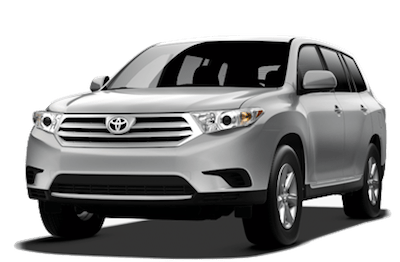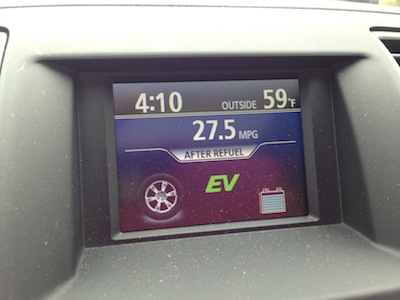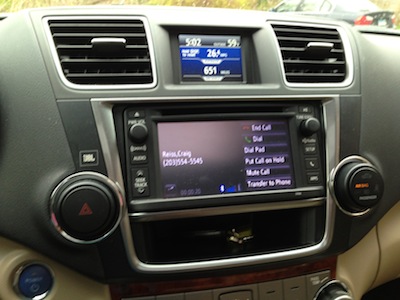2013 Toyota Highlander Hybrid: Helping Us to Save the World (And Drive the Carpool)

 The word ‘revolutionary’ should be used carefully. The telephone was revolutionary. So was the computer. And the car. They changed the way we live our lives, escalated our progress and helped us to see our future with new possibilities.
The word ‘revolutionary’ should be used carefully. The telephone was revolutionary. So was the computer. And the car. They changed the way we live our lives, escalated our progress and helped us to see our future with new possibilities.
So it’s not lightly that I think of the Toyota Highlander Hybrid as revolutionary.
When Toyota introduced the Prius, we got it: everything about the Prius–its shape, its size, its weight–was designed for maximum efficiency, especially the hybrid engine and oversized battery that Toyota developed for it. It was perfect for those consumers who wanted a small car with great gas mileage and who could live their lives in such a car.
But not customers like me.
Because I have two kids, a carpool, long road trips, snowy winters and hilly roads to travel. A Prius might be good on some days, but not all days. Understanding this, and believing strongly in the new hybrid engine that they developed, Toyota made a nervy move: They put it in the Highlander.
And for me, that was revolutionary. In the fall of 2005 the Highlander Hybrid, with its seven passenger, three row seating, all wheel drive and truck-like feel, rolled off the assembly line and into my driveway. The same week, gas spiked to $4 a gallon. My Jeep, which had gotten 15 MPG and demanded mid-grade fuel, would cost me more than $300 a month for gas. The Highlander Hybrid, with its better gas mileage and use of regular gas, would cost $120 a month.
Perhaps in the grand scheme of things and considering the cost of the car–I paid about $40,000 for it–$180 a month wasn’t a huge savings, and perhaps I could have even saved more by buying a less expensive car.
The Real Revolution: Changing the Way Automakers Think

By voting with my dollars for a more efficient way to drive the vehicle I needed–and a vehicle that has near zero emissions, a bonus I didn’t realize I would love as much as I do–I helped to change the world. In 2005 there was ONE car on the road with alternative technology: The Prius. Now, eight short years later, nearly every car manufacturer is in this field (maybe EVERY manufacturer?).
And consumers have huge choices: Trucks, sedans, sports cars, turbos, compacts, wagons, you name it, there is a fuel efficient way to get where you’re going and with the style, performance and comfort you choose. The Highlander Hybrid changed the way we live our lives, escalated our progress and helped us to see the possibilities of our future.
Small Increase in Gas Mileage, Huge Increase in Creature Comforts

Even Better Gas Mileage

More Importantly, Leg Room
Then, there are the all important creature comforts, because my kids don’t really care about gas mileage as much as they care about leg room. When we first got the Highlander Hybrid, the third row was tiny. But it was perfect: my three and six year old daughters felt as if it were made just for them. They scrambled into the third row and happily rode for hours; they fought over who could sit there with a friend; they sat in the back together like it was their own personal limousine.
And then they grew. Soon they were fighting over who HAD to sit in the back and were begging not to be chosen. Soon we stopped using the third row altogether.

With Extra Space Comes Extra Storage
In addition to making the Highlander bigger and more comfortable, Toyota’s designers focused on finding storage and convenience everywhere they could. As a result, there were plenty of cup holders, a nice little shelf in the center console where I could put keys or
my phone, and a sizable console between the front seats. Then, there was the flexibility of the center row and some very cool storage and convenience options, which you’ll see in the video here.
Toyota, like so many other automakers, realized that if drivers can see when and where they maximize fuel usage, they might learn to drive more efficiently. They introduced a driver feedback system with the Hybrid model in 2006; many new cars come equipped with systems like this today. Toyota sort of zigged on this one, and I’m fine with it: The driver feedback information is basic and not integrated into other driver information pods; it’s in its own unintrusive little window with simple easy to read graphics.
The Real Reason to Love An SUV: Hauling Stuff
I hauled home nearly my entire house in my SUVs. Wine refrigerator. Dining room table and chairs. Kitchen table and chairs. Kids beds. My bed. Flat screen TV. Kids playhouse. Patio dining table and chairs (two trips but saved hundreds of dollars on shipping). The Highlander Hybrid makes me feel so much better about this as I chug up the hill behind a overnight delivery truck spewing diesel fumes and think, not only did I save significant money, but my truck isn’t heaving black soot into the air.
And when hauling stuff is an impulsive move, all the better. During the week I had the 2013 Highlander Hybrid I happened to stop into a Home Goods store and by a magical stroke of luck, found the most amazingly perfect chair for my living room. Lucky for me, I was able to just ask them to load it into the car and it went home with me. You can see how we got it all in the car here:{youtube}Q1jtH-XFOF0{/youtube}
I’m not sure I’m ready to give up my 2006 Highlander Hybrid; it was my investment in the future of the auto industry, and a winning investment at that. I am beyond delighted that not only has Toyota remained a leader building these amazing cars, but that they continue to refine it and make it better and better. So then, again, maybe I should consider trading mine in for the new model. It made my kids almost as happy as I am with the Highlander.
What We Loved
Gas Mileage: 27 MPG in a seven passenger SUV ROCKS
Seven passenger seating with plenty of leg room and head room
Uses regular gas
Great technology in the media console (navigation, connected phone features, satellite radio and more)
Voice-operated media controls (phone, navigation, etc)
Streaming Bluetooth (maybe my favorite media feature)
Good front seat storage options
A heavier, more substantial truck feel than the original model year
4 Wheel Drive
V6 Engine, 280 horsepower
Super Ultra Low Emissions (which means nearly zero, not really discernible emissions)
What You Need to Know
Base price, about $42,000
Price of the model we tested: $47,573
Three year, 36,000 mile warranty
The model we tested was pretty fully loaded, but other available options include an in-car DVD system
Disclosure: Toyota loaned me the 2013 Highlander Hybrid for my review; opinions and experiences reflected here are purely my own.
